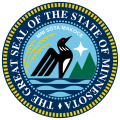| |||||||||||||||||||||
| |||||||||||||||||||||
| |||||||||||||||||||||
The 1890 Minnesota lieutenant gubernatorial election was held on November 4, 1890, in order to elect the lieutenant governor of Minnesota. Republican nominee and incumbent member of the Minnesota Senate from the 27th district Gideon S. Ives defeated Democratic nominee Eggert G. Pahl and Prohibition nominee J.O. Barrett. [1]


